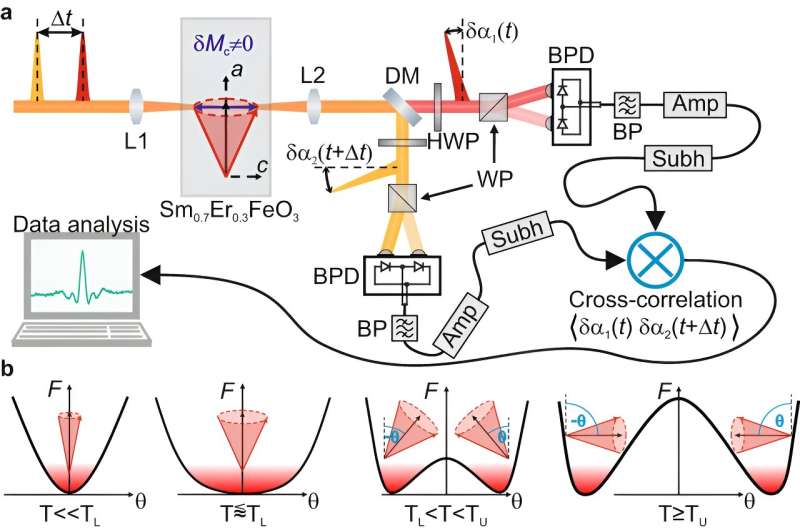
Researchers at the University of Konstanz have discovered a new type of ultrafast magnetic switching by investigating fluctuations that normally tend to interfere with experiments as noise.
Noise on the radio when reception is poor is a typical example of how fluctuations mask a physical signal. In fact, such interference or noise occurs in every physical measurement in addition to the actual signal.
"Even in the loneliest place in the universe, where there should be nothing at all, there are still fluctuations of the electromagnetic field," says physicist Ulrich Nowak.
In the Collaborative Research Center (CRC) 1432 "Fluctuations and Nonlinearities in Classical and Quantum Matter beyond Equilibrium" at the University of Konstanz, researchers do not see this omnipresent noise as a disturbing factor that needs to be eliminated but as a source of information that tells us something about the signal.
No magnetic effect, but fluctuations
This approach has now proved successful when investigating antiferromagnets. Antiferromagnets are magnetic materials in which the magnetizations of several sub-lattices cancel each other out. Nevertheless, antiferromagnetic insulators are considered promising for energy-efficient components in the field of information technology. As they have hardly any magnetic fields on the outside, they are very difficult to characterize physically. Yet, antiferromagnets are surrounded by magnetic fluctuations, which can tell us a lot about this weakly magnetic material.
In this spirit, the groups of the two materials scientists Ulrich Nowak and Sebastian Gönnenwein analyzed the fluctuations of antiferromagnetic materials in the context of the CRC. The decisive factor in their theoretical as well as experimental study, recently published in the journal Nature Communications, was the specific frequency range.
"We measure very fast fluctuations and have developed a method with which fluctuations can still be detected on the ultrashort time scale of femtoseconds," says experimental physicist Gönnenwein. A femtosecond is one millionth of a billionth of a second.
New experimental approach for ultrafast time scales
On slower time scales, one could use electronics that are fast enough to measure these fluctuations. On ultrafast time scales, this no longer works, which is why a new experimental approach had to be developed. It is based on an idea from the research group of Alfred Leitenstorfer, who is also a member of the Collaborative Research Center. Employing laser technology, the researchers use pulse sequences or pulse pairs in order to obtain information about fluctuations.
Initially, this measurement approach was developed to investigate quantum fluctuations, and has now been extended to fluctuations in magnetic systems. Takayuki Kurihara from the University of Tokyo played a key role in this development as the third cooperation partner. He was a member of the Leitenstorfer research group and the Zukunftskolleg at the University of Konstanz from 2018 to 2020.
Detection of fluctuations using ultrashort light pulses
In the experiment, two ultrashort light pulses are transmitted through the magnet with a time delay, testing the magnetic properties during the transit time of each pulse, respectively. The light pulses are then checked for similarity using sophisticated electronics. The first pulse serves as a reference, the second contains information about how much the antiferromagnet has changed in the time between the first and second pulse. Different measurement results at the two points of time confirm the fluctuations. Nowak's research group also modeled the experiment in elaborate computer simulations in order to better understand its results.
One unexpected result was the discovery of what is known as telegraph noise on ultrashort time scales. This means that there is not only unsorted noise, but also fluctuations in which the system switches back and forth between two well-defined states. Such fast, purely random switching has never been observed before and could be interesting for applications such as random number generators. In any case, the new methodological possibilities for analyzing fluctuations on ultrashort time scales offer great potential for further discoveries in the field of functional materials.
More information: M. A. Weiss et al, Discovery of ultrafast spontaneous spin switching in an antiferromagnet by femtosecond noise correlation spectroscopy, Nature Communications (2023). DOI: 10.1038/s41467-023-43318-8
Provided by University of Konstanz
Citation: Scientists discover new type of ultrafast magnetic switching while investigating noise interference (2023, November 29) retrieved 30 November 2023 from https://ift.tt/j2sRWdl
This document is subject to copyright. Apart from any fair dealing for the purpose of private study or research, no part may be reproduced without the written permission. The content is provided for information purposes only.
"type" - Google News
November 29, 2023 at 11:00PM
https://ift.tt/oRSaDrI
Scientists discover new type of ultrafast magnetic switching while investigating noise interference - Phys.org
"type" - Google News
https://ift.tt/EB02ieX
https://ift.tt/fLYCxcJ
Bagikan Berita Ini














0 Response to "Scientists discover new type of ultrafast magnetic switching while investigating noise interference - Phys.org"
Post a Comment